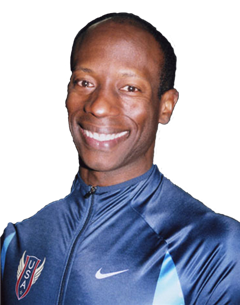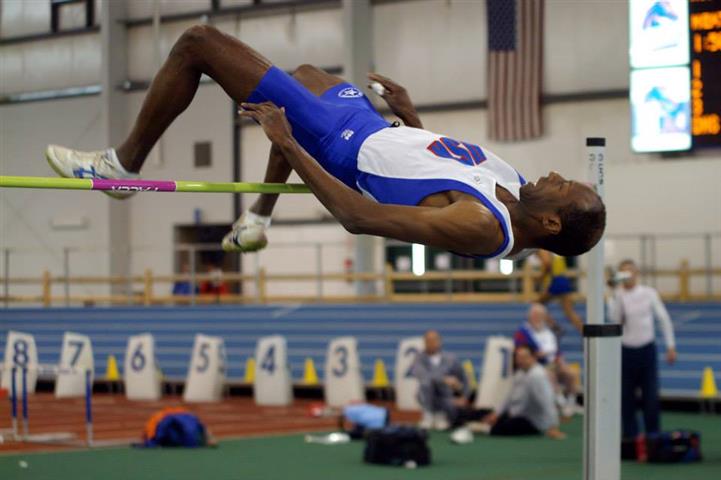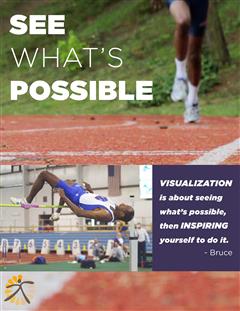
Bruce McBarnette

Advice from World Record Breaker Bruce McBarnette

Advice from World Record Breaker Bruce McBarnette
Exercise. And exercise some patience, too.
Exercising should be enjoyable. If it’s not, it means you haven’t found the sport or activity that’s right for you. It’s also easy to expect instant gratification: our culture is accustomed to it through access to the Internet and social networks. But being an athlete requires some patience. As a Masters high jumper, I spent nine years earning second- and third-place finishes before winning my first championship. If I’d been impatient with my progress, I could’ve given up and moved on to something else. However, I didn’t spend nearly a decade before winning my first event because I wasn’t enjoying myself, either in training or competition. I kept at it because I was enjoying myself. And finally winning was one of the many rewards of participating in a sport I love. Since then, I’ve won 24 USA National Masters Track and Field championships, eight world championships—including in 2008 at that event in Clermont-Ferrand, where I also made several exhilarating-yet-unsuccessful attempts at the world record for my age group. I’ve also broken 11 American records. Along the way, I’ve made countless friends and visited dozens of countries, and those might be the most important wins.
See what’s possible.
A big part of my success as an athlete starts with my mind. I regularly practice visualization techniques, rehearsing in my head what I’m trying to accomplish physically. By doing this, I start tomobilize the resources inside me—both mentally and physically, whether it’s to attempt a world record height in the high jump, make a golf shot, or catch a wave surfing. Visualization techniques are proven to work, and they inspire a confidence that connects your mind and body to what’s possible. Visualization is about seeing what’s possible, and then inspiring yourself to realize those possibilities.
I teach classes that help students prepare for several professional exams, such as the LSAT, GRE, and GMAT. One of the lessons I focus on is the importance of envisioning success with the test. And I’ll tell you this: the younger students do this easily, while the older students tend to struggle. This has nothing to do with mental ability; it’s simply about being open to the idea that visualization works. But it’s an innate ability, part of the human creative spirit. As we age, we’re pressured to conform and shepherded to think in a certain way, and this ability to creatively visualize is unrewarded or suppressed. The good news is that you can get this ability back very quickly with practice. You just have to be open to the idea.
VIDEO: Recognizing Role Models


Fit Behavior Mini eBook
(click on image to download)
My first championship, a decade in the making.
Older athletes should be celebrated. Our culture emphasizes the extraordinary physical abilities of young athletes. Don’t get me wrong: major leaguers and Olympians and extreme sports stars deserve our attention. They’re inspiring. But they represent a tiny fraction of our athletic population and—unrealistically—end up serving as measuring sticks for the rest of us. As a result, “ older” athletes—and older is a relative term—aren’t recognized enough because they can’t do what the top one percent of the top one percent of 20-somethings can do.
When I competed in the 2008 Masters World Championships in Clermont-Ferrand, France, I was one of 132 American athletes participating. Compare that number to 287 athletes from Great Britain, 387 from Germany, and 1,288 from France. While the distance American athletes needed to travel to participate might have influenced those counts, the main reason for the difference is the number of Masters-level athletic club teams we have here in the United States. Compared to our European counterparts, we have a lot fewer clubs to join, whether in rowing, track and field, running or other sports. Ultimately, we have fewer older athletes participating in sports.
I once asked a young person who had just watched a Masters track and field meet what they thought of the event. His response? It was “ depressing” watching “ old” people trying to do things—like the shot put or discus throw—that young people could obviously do much better. This reaction demonstrates that our perspective on what it means to be an athlete in your fifties, sixties, seventies and beyond, needs to change. Older athletes shouldn’t be seen for their inability to equal the accomplishments of younger athletes; they should be recognized for their abilities as athletes, period. Older athletes are competing against other older athletes and, more importantly, themselves—not LeBron James or Usain Bolt. The goal is to push yourself to be better than you are now—at any age.
There are more good reasons to be an athlete than good excuses not to be.
Some of this perception of older athletes is self-imposed. By now, we all know that we should be exercising. Physical fitness is inextricably linked to our health: Exercising boosts our immune systems, preserves and even advances our mental acuity, protects us from disease, and much more. None of this is news, so it’s perplexing how otherwise intelligent people are able to talk themselves out of exercising.
Some say that they don’t have the time. While it’s true that many of us lead busy lives, we have to make time for what’s important. Exercising, for the reasons already mentioned, is clearly important to our well-being. So what’s more important than doing what we need to do to stay healthy, happy, and productive?
Another excuse I hear, especially among my peers, is that they have worked hard their whole lives, so now they want to relax. I have two responses to this line of thinking. First, being physically fit extends our lives, and while I haven’t retired yet, I want my retirement to be as long as possible. To put it bluntly, living longer with exercise seems a lot more appealing than dying younger without exercise. Second, retirement gives us the time we didn’t have when we were working to try new things. Many of my retired friends have since wondered aloud how they ever had any time for work because they’ve discovered so many interesting new activities.
And the truth is, the more fit you are, the more available these activities are to you. Consider a friend of mine. He’s working less nowadays, though he hasn’t retired entirely. Instead, he’s gradually getting out of the real estate business and into the grandchildren business. Without retiring completely, he wants to spend less time working and more time with them. And anyone with grandchildren knows that young kids don’t sit still very long. If you want to spend time with them, you have to keep up with them. That requires physical fitness.
VIDEO: Bruce Creating A Habit
The first time I competed at a Masters swimming event, I had similar fears. I’d been enjoying getting into shape, and my coach urged me to compete. I was hesitant, but I still said “yes.” I still had visions of being unable to finish the distance, and looking like a fool. But those were just fears— not even reasonable, just petty. The bad news is that we all seem to have these kinds of fears. The good news is that we can leave them behind. First, by saying “yes.” Second, by rethinking what it means to fail. If failing is just an early indication of eventual success—and I believe it is— we should aspire to fail more often. “Relaxing” does not sound as fun as what I’m doing. When I retire, I’ll just have more time to play.
Find a sport you love, and then find some more.
Finding a sport or activity that you love is crucial. And it doesn’t have to be a competitive sport. Yoga and tai chi are physical activities without any competitive element that offer extraordinary health benefits. When you find a sport or activity that’s right for you, you’ll know it. For one, your body will actually crave the activity, especially if you make it a habit. The other benefit is social—it’ll come with new friends and acquaintances. For me, the high jump has been a big part of my life. The places I’ve been and the people I’ve met have revolved around my passion and dedication to jumping over a bar. But the places, people, and competitions have added an irreplaceable richness to my life.
As much as I love the high jump, I couldn’t spend 12 hours a day doing it. So it feels strange that we face pressure to specialize and excel in one pursuit. Trying new things can help us unlock our talents, and pushes us to grow. When I first joined the track and field team at Princeton, where I earned my undergraduate degree, I was only looking for a way to stay in shape during the football offseason. In high school, I excelled in football, and eventually played on the varsity team at Princeton. I’d never participated in track and field before. When I approached the coach about joining the team, he said he already had plenty of runners. He noted that I was tall, and asked if I’d be interested in trying the high jump. I didn’t know how big a part of my life the high jump would become. Instead, I was simply open to a new idea.
Even though I’ve found a sport I truly love, I know I have to mix it up. I surf whenever I can (I first learned while living in Hawaii). And I love Ultimate (sometimes referred to as Ultimate Frisbee), as well as snorkeling and scuba diving. Engaging in different activities keeps me fresh and interested, and lets me use and strengthen different muscles. When you find several activities you really enjoy, cross-training can become a lot more than just a way of working out. It can become a lifestyle, one you’ll never be too old for. Ever. When it comes to physical fitness, there’s a sport or activity out there for all of us. That is never in question. The real question how far witness will take you. I think you’ll be amazed at the answer.
FitBehavior Change Journey
Bruce, though quite elite as an athlete, stresses the importance of self-motivation when changing behavior. Fostering confidence from previous success in other endeavors helps generate the confidence to try new things. And trying new things is a significant factor in maintaining healthy behavior because it renews your interests and keeps daily life fresh.
Interest:
•Decided to not quit playing sports as an adult.
Alignment:
•Discovered masters-sports opportunities
•Tapped into confidence from previous success to compete on this stage.
Commitment:
•Committed to win a National Championship and World Championship.
Action:
•Visualized success
•Prioritized his schedule to accommodate training
•Patient and persistent to continue competing nine years before finally winning his first National Championship.
Renewal:
•Cross-trains in other sports/activities to keep it fresh
•Acknowledges benefits: confidence to do other things, health benefits, social benefits, overall quality of life
•Serves as a mentor/role model to others, which fuels motivation to continue
Key Takeaways:
•Visualize yourself doing what is you want to do.
•Diversify your portfolio of activities
•Be open to exposing your hidden talents
•Recall previous success to boost your confidence in new ventures
•Seek mentors and or role models to guide you through insecurities
Inspire your FitBehavior: Real people. Real results. Real motivation.
Text Copyright © 2012 Forever Athletes LLC, d/b/a FitBehavior
Video Copyright © 2012 Forever Athletes LLC, d/b/a FitBehavior
Compilation copyright © 2012 Forever Athletes LLC, d/b/a FitBehavior
All rights reserved. No part of this book may be used or reproduced by any means, graphic, electronic, or mechanical, including photocopying, recording, taping or by any information storage retrieval system without the written permission of the publisher except in the case of brief quotations embodied in critical articles and reviews.
ISBN 9780983032892
Professional athletes offer an image of athletic accomplishment that is helpful and often worth emulating—especially for kids. But the importance of adults recapturing their ability to visualize underscores the need for older athletes to inspire their friends and peers. Witnessing older athletes participate and compete can give us the inspiration and encouragement to get out there as well. As we get older, we tend to become less flexible in our thinking and more self-conscious about appearing unknowledgeable, inexperienced, or out of place. Having friends and peers who can invite us into an activity, and guide us through those early insecurities, can be very helpful. If you already have people in your life who fit this description, take them up on their invitations. And if you don’t have people in your life who are athletic role models, seek them out. They’re out there.